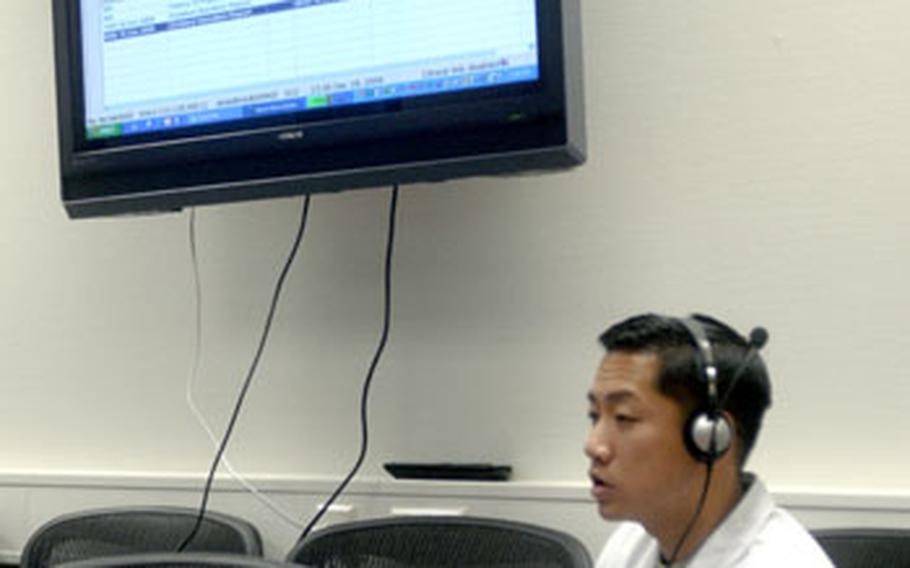
Maj. (Dr.) Hamilton Le, a surgeon at Landstuhl Regional Medical Center in Germany, demonstrates voice-recognition software new to the hospital. It allows doctors to have their notes typed out as they speak. Le talks into the headset microphone and his words appear on the computer. (Steve Mraz / Stars and Stripes)
LANDSTUHL, Germany — Doctors at Landstuhl Regional Medical Center received a few new toys in time for Christmas.
Actually, some of the new information technology gadgets have been around for months, but the hospital is now beginning to promote its enhanced features. The new capabilities have Landstuhl at the forefront of an Army medicine information technology initiative sponsored by the surgeon general of the Army. The goal is to improve the delivery of health care to patients, doctors said.
In a visit to Landstuhl last week, Lt. Gen. Eric Schoomaker, the Army’s surgeon general, received demonstrations on how the hospital is leveraging its new IT advancements in an effort to improve patient care.
"It’s going to provide in this healing environment what the war fighter has within their environment ... universal access to critical information that allows us to precisely intervene in the lives of our patients in a positive way," Schoomaker said.
Here are the tools in place at Landstuhl with examples of their practical use:
Touch-screen laptop computers allow doctors to take notes with a stylus. Example: A bedridden patient could sign off on his or her records on their doctor’s computer screen.A wireless network provides doctors access to real-time patient records from anywhere in the hospital. Example: In between bites of lunch at the dining facility, a doctor could view updates on her patients’ status.Voice-recognition software new to the hospital does away with the need for doctors’ operative notes to be transcribed, readying the notes in a fraction of the time it used to take. Example: When a doctor talks into a microphone hooked up to his computer, his notes appear in writing and can be confirmed much faster than the traditional method.Use of another enhancement, an iPod-size communications device, has been shelved until sometime in 2009 out of software and security issues. The voice-activated device functions over the wireless network and allows doctors to talk to each other while inside the hospital. Example: Instead of hoping to be in an area of the sprawling hospital that gets cell phone reception, doctors can reliably and immediately speak with each other at work.
Trainers worked with the staff members in early December to get them knowledgeable and comfortable with some of the new technology and gear so health care providers will embrace the changes.
The wireless network and the laptop "tablet" computers give Landstuhl’s health care providers freedom of movement in a hospital that can accurately be described as mazelike.
"If I go up to the [intensive care unit] and want to use one of their computers, I’m not going to have access to all of the features that I’ve dialed in [on my laptop]," said Army Dr. (Col.) Stephen Flaherty, director of Landstuhl’s trauma program. "Because we’ve got wireless access, I can undock my tablet, walk up to the ICU and now I have all of the things that make me more efficient."
So why should patients care about all these gee-whiz gizmos?
The less time doctors spend doing paperwork, the more time they can spend treating patients, doctors said.
"Even though it’s making my life a little easier, proficient, et cetera, in the end this is all about patient care — taking care of those wounded warriors that are coming through LRMC, taking care of the family members, all the soldiers who are stationed locally," said Army Dr. (Maj.) Hamilton Le, a Landstuhl surgeon. "This is about taking care of those people."
The voice-recognition software seems particularly well-suited for Landstuhl’s role in the medical evacuation process.
Typically, troops wounded in Iraq and Afghanistan stay at Landstuhl two to three days before being flown to the States.
Under the traditional method of transcribing doctors’ operative notes, days could pass before the notes from Landstuhl doctors would be available to military doctors in the States.
"It’s very easy for that patient to have been long gone before that report ever gets back," Le said. "For me to convey that to the other surgeon who’s going to operate on him again before that report even gets back, for me to sit down and type everything, it would take too long. … Now I can dictate and an immediate report is available. They can print that off or e-mail it those surgeons, and it’s available like that."
With the military’s love of jargon and acronyms, the voice recognition software has to be "taught" a few words and phrases. During a demonstration of the software, Le spoke into his microphone and used a hypothetical scenario in which he operated on a patient who had been injured in an improvised explosive device blast.
However when his words appeared on screen, "IED" had been recognized by the software as an "IUD" blast. In medical terms, IUD stands for intrauterine contraceptive device.